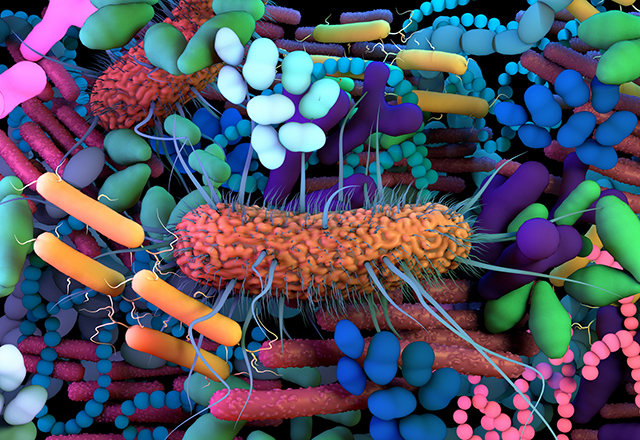Multidrug antibiotic resistance has become one of the most significant clinical problems. Despite billions of dollars invested in research and stewardship programs to regulate antibiotic use and reduce the spread of resistant infections, bacteria continue to evolve to become resistant not only to antibiotics but also to biocides commonly used in hospitals.
The existence of this problem has led to the development of promising therapies, including the use of artificial intelligence to create new antibiotics, bacteriophages to suppress specific bacterial populations, and systematic screening for previously unknown antimicrobial compounds in previously unexplored organisms [1].
However, certain bacterial behaviors remain poorly understood and may generate future obstacles for therapy. Many bacteria are known to be part of the healthy human microbiome, yet some of them can acquire pathogenic properties that can evolve into serious infections for the host.
Staphylococcus epidermidis, for example, is a commensal bacterium from human skin and is considered a marker of a healthy skin microbiome. Nonetheless, several reports exist of S. epidermidis strains that acquire pathogenic phenotypes and develop serious infections of the eye, conjunctiva or skin. These characteristics can change from strain to strain and can go from biofilm production and composition to the increase in drug resistance mechanisms like efflux pumps [2].
Similarly, Escherichia coli can present itself as an inhabitant of the human intestine or as one of the most dangerous pathogenic bacteria: strain O157:H7, also known as enterohemorrhagic E. coli (EHEC), an E. coli strain that secretes a dangerous toxin inducing hemorrhagic diarrhea. Furthermore, the E. coli variability does not stop there, as there is another strain known as Shiga toxin E. coli (STEC) that can produce Verocytotoxin, promoting kidney damage to hemorrhagic diarrhea [3].
How can bacteria belonging to the same species produce such distinct outcomes in their host?
The reality is that bacteria evolution is more dynamic than often assumed. With the existence of at least five different pathotypes in E. coli, it is clear that bacteria can easily receive DNA from the environment and make the most it can with it. The commensal strain of E. coli has a genomic backbone of about 4.1 Mb that is shared between all the pathovariants, but the enterohemorrhagic strain possesses a genome of more than 5 Mb. This difference suggests the gain or loss of over 1,000 base pairs during natural selection, organized into what are known as pathogenicity islands [4].
Only recently have phylogenetic studies started to dig into the evolution of the different strains of E. coli by comparing the pathovariants and commensal strains with other strains existing in wild animals. The findings show that genetic transfer and gene loss in the bacterial world are very complex fields in bacterial selection and evolution. Lu et al. found that, in Marmota himalayana, eight of the 12 pathogenic E. coli strains share a most recent common ancestor with one or more marmot-associated E. coli strains. Remarkably, human commensal E. coli might be a recent strain of E. coli with the loss of the pathogenic genes [5].
While this recent information is coming to light, more bacteria species are showing similar behavior, like S. epidermidis mentioned above. However, in many cases, pathogenicity in this bacteria species is still ligated to subtle changes in gene expression caused by small mutations.
These seemingly minor differences within a single bacterial species deserve close attention. Multidrug-resistant strains, pathogenic variants, genetically modified microorganisms, and insufficient wastewater treatment in many countries can exponentially accelerate horizontal gene transfer between species, compounding the difficulty of controlling zoonotic and nosocomial infections [6].
Multidrug resistance reveals that bacterial pathogenicity is dynamic, driven by genomic plasticity, horizontal gene transfer, and subtle regulatory changes. Even commensals such as E. coli or S. epidermidis can acquire pathogenic traits with severe clinical outcomes. These findings underscore the importance of monitoring microbial evolution across genomes and ecosystems, where even small genetic differences can significantly impact host health or disease. Meeting this challenge demands integrated approaches that combine next-generation therapies: AI-guided antibiotics, phage treatments, and microbiome modulation; with global measures on antibiotic use, sanitation, and surveillance. Without such coordination, accelerating genetic exchange will continue to fuel infections faster than we can control them.
References:
- Torres, M. D. T., Wan, F., & de la Fuente-Nunez, C. (2025). Deep learning reveals antibiotics in the archaeal proteome. Nature microbiology, 10(9), 2153–2167. https://doi.org/10.1038/s41564-025-02061-0
- García-Gómez, E., Jaso-Vera, M. E., Juárez-Verdayes, M. A., Alcántar-Curiel, M. D., Zenteno, J. C., Betanzos-Cabrera, G., Peralta, H., Rodríguez-Martínez, S., Cancino-Díaz, M. E., Jan-Roblero, J., & Cancino-Diaz, J. C. (2017). The 95ΔG mutation in the 5'untranslated region of the norA gene increases efflux activity in Staphylococcus epidermidis isolates. Microbial pathogenesis, 103, 139–148. https://doi.org/10.1016/j.micpath.2016.12.021
- Lim, J. Y., Yoon, J., & Hovde, C. J. (2010). A brief overview of Escherichia coli O157:H7 and its plasmid O157. Journal of microbiology and biotechnology, 20(1), 5–14.
- Pakbin, B.; Brück, W.M.; Rossen, J.W.A. Virulence Factors of Enteric Pathogenic Escherichia coli: A Review. J. Mol. Sci. 2021, 22, 9922. https://doi.org/10.3390/ijms22189922
- Lu, S., Jin, D., Wu, S., Yang, J., Lan, R., Bai, X., Liu, S., Meng, Q., Yuan, X., Zhou, J., Pu, J., Chen, Q., Dai, H., Hu, Y., Xiong, Y., Ye, C., & Xu, J. (2016). Insights into the evolution of pathogenicity of Escherichia coli from genomic analysis of intestinal E. coli of Marmota himalayana in Qinghai-Tibet plateau of China. Emerging microbes & infections, 5(12), e122. https://doi.org/10.1038/emi.2016.122
- Brown, C. L., Maile-Moskowitz, A., Lopatkin, A. J., Xia, K., Logan, L. K., Davis, B. C., Zhang, L., Vikesland, P. J., & Pruden, A. (2024). Selection and horizontal gene transfer underlie microdiversity-level heterogeneity in resistance gene fate during wastewater treatment. Nature communications, 15(1), 5412. https://doi.org/10.1038/s41467-024-49742-8
Related Content
- Underappreciated, Not Unimportant: Fungal Infections and Antifungal Resistance
- A Viral Solution to Antibiotics Weakness
- The Cost of Preventing Pediatric Influenza Deaths
Want to read more from the Johns Hopkins School of Medicine? Subscribe to the Biomedical Odyssey blog and receive new posts directly in your inbox.
